Réincarnation - renaissance - les travaux de Ian Stevenson
Ian Stevenson (né le 31 octobre 1918 à Montréal au Canada et mort le 8 février 2007 à Charlottesville aux États-Unis), est un professeur et un psychiatre et le fondateur de la recherche scientifique sur la réincarnation.
De 1967 à sa mort, il fut le directeur de la Division sur les Études de la Personnalité (DOPS) et professeur du Département de Psychiatrie à l'Université de Virginie. Il est connu pour avoir collecté et méticuleusement recherché des cas d'enfants s'étant rappelés leur vies antérieures. (spontanément, sans l'aide de l'hypnose).
Ian Stevenson a publié seulement pour les communautés scientifiques et académiques; ses publications sont densément fournies en détails de recherche et arguments académiques. Ses recherches, quelque 3000 cas d'étude, fournissent des témoignages suggestifs de réincarnation. Certains moines bouddhistes mentionnent ses travaux comme "prouvant scientifiquement la réincarnation".
Livres traduits en français :
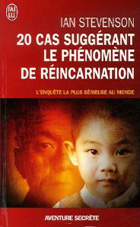 |
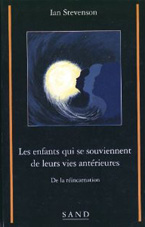 |
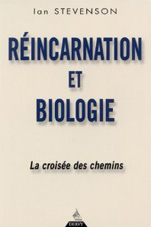 |
cliquer ici pour avoir le texte ci-dessous traduit automatiquement en français par Google
Dr. Ian Stevenson - The Pioneer of Reincarnation Research
Ian Stevenson is the former head of the Department of Psychiatry at the University of Virginia, and now is Director of the Division of Perceptual Studies at the University of Virginia. He has devoted the last 40 years to the scientific documentation of past life memories of children from all over the world and has over 3000 cases in his files. Many people, including skeptics and scholars, agree that these cases offer the best evidence yet for reincarnation.
Dr. Stevenson's research into the possibility of reincarnation began in 1960 when he heard of a case in Sri Lanka where a child claimed to remember a past life. He thoroughly questioned the child and the child's parents, as well as the people whom the child claimed were his parents from his past life. This led to Dr. Stevenson's conviction that reincarnation was possibly a reality. The more cases he pursued, the greater became his drive to scientifically open up and conquer an unknown territory among the world's mysteries, which until now had been excluded from scientific observation. Nonetheless, he believed he could approach and possibly furnish proof of its reality with scientific means.
In 1960, Dr. Stevenson published two articles in the Journal of the American Society for Psychical Research about children who remembered past lives. In 1974, he published his book, Twenty Cases Suggestive of Reincarnation, and became well known wherever this book appeared by those people who already had a long-standing interest in this subject. They were pleased to finally be presented with such fundamental research into reincarnation from a scientific source. In 1997, Dr. Stevenson published his work entitled Reincarnation and Biology. In the first volume, he mainly describes birthmarks - those distinguishing marks on the skin which the newborn baby brings into the world and cannot be explained by inheritance alone. In his second volume, Dr. Stevenson focuses mainly on deformities and other anomalies that children are born with and which cannot be traced back to inheritance, prenatal or perinatal (created during birth) occurrences. This monumental piece of work contains hundreds of pictures documenting the evidence.
During his original research into various cases involving children's memories of past lives, Dr. Stevenson did note with interest the fact that these children frequently bore lasting birthmarks which supposedly related to their murder or the death they suffered in a previous life. Stevenson's research into birthmarks and congenital defects has such particular importance for the demonstration of reincarnation, since it furnishes objective and graphic proof of reincarnation, superior to the - often fragmentary - memories and reports of the children and adults questioned, which even if verified afterwards cannot be assigned the same value in scientific terms.
In many cases presented by Dr. Stevenson there are also medical documents available as further proof, which are usually compiled after the death of the person. Dr. Stevenson adds that in the cases he researched and "solved" in which birthmarks and deformities were present, he didn't suppose there was any other apposite explanation than that of reincarnation. Only 30% - 60% of these deformities can be put down to birth defects which related to genetic factors, virus infections or chemical causes (like those found in children damaged by the drug Thalidomide or alcohol). Apart from these demonstrable causes, the medical profession has no other explanation for the other 40% to 70% of cases than that of mere chance. Stevenson has now succeeded in giving us an explanation of why a person is born with these deformities and why they appear precisely in that part of their body and not in another.
Most of the cases where birthmarks and congenital deformities are present for which no medical explanations exist have one to five characteristics in common.
(1) In the most unusual scenario, it is possible that someone who believed in reincarnation expressed a wish to be reborn to a couple or one partner of a couple. This is usually because they are convinced that they would be well cared for by those particular people. Such preliminary requests are often expressed by the Tlingit Indians of Alaska and by the Tibetans.
(2) More frequent than this are the occurrences of prophetic dreams. Someone who has died appears to a pregnant or not as yet pregnant woman and tells her that he or she will be reborn to her. Sometimes relatives or friends have dreams like this and will then relate the dream to the mother to be. Dr. Stevenson found these prophetic dreams to be particularly prolific in Burma and among the Indians in Alaska.
(3) In these cultures the body of a newborn child is checked for recognizable marks to establish whether the deceased person they had once known has been reborn to them. This searching for marks of identification is very common among cultures that believe in reincarnation, and especially among the Tlingit Indians and the Igbos of Nigeria. Various tribes of West Africa make marks on the body of the recently deceased in order to be able to identify the person when he or she is reborn.
(4) The most frequently occurring event or common denominator relating to rebirth is probably that of a child remembering a past life. Children usually begin to talk about their memories between the ages of two and four. Such infantile memories gradually dwindle when the child is between four and seven years old. There are of course always some exceptions, such as a child continuing to remember its previous life but not speaking about it for various reasons.
Most of the children talk about their previous identity with great intensity and feeling. Often they cannot decide for themselves which world is real and which one is not. They often experience a kind of double existence where at times one life is more prominent, and at times the other life takes over. This is why they usually speak of their past life in the present tense saying things like, "I have a husband and two children who live in Jaipur." Almost all of them are able to tell us about the events leading up to their death.
Such children tend to consider their previous parents to be their real parents rather than their present ones, and usually express a wish to return to them. When the previous family has been found and details about the person in that past life have come to light, then the origin of the fifth common denominator – the conspicuous or unusual behavior of the child - is becoming obvious.
(5) For instance, if the child is born in India to a very low-class family and was a member of a higher caste in its previous life, it may feel uncomfortable in its new family. The child may ask to be served or waited on hand and foot and may refuse to wear cheap clothes. Stevenson gives us several examples of these unusual behavior patterns.
In 35% of cases he investigated, children who died an unnatural death developed phobias. For example, if they had drowned in a past life then they frequently developed a phobia about going out of their depth in water. If they had been shot, they were often afraid of guns and sometimes loud bangs in general. If they died in a road accident they would sometimes develop a phobia of traveling in cars, buses or lorries.
Another frequently observed unusual form of behavior, which Dr. Stevenson called philias, concerns children who express the wish to eat different kinds of food or to wear clothes that were different from those of their culture. If a child had developed an alcohol, tobacco or drug addiction as an adult in a previous incarnation he may express a need for these substances and develop cravings at an early age.
Many of these children with past-life memories show abilities or talents that they had in their previous lives. Often children who were members of the opposite sex in their previous life show difficulty in adjusting to the new sex. These problems relating to the 'sex change' can lead to homosexuality later on in their lives. Former girls who were reborn as boys may wish to dress as girls or prefer to play with girls rather than boys.
Until now all these human oddities have been a mystery to conventional psychiatrists - after all, the parents could not be blamed for their children's behavior in these cases. At long last research into reincarnation is shedding some light on the subject. In the past, doctors blamed such peculiarities on a lack or a surplus of certain hormones, but now they will have to do some rethinking.
The following paper by Dr. Stevenson was presented at the Eleventh Annual Meeting of the Society for Scientific Exploration held at Princeton University. June 11-13, 1992. The title of the paper is "Birthmarks and Birth Defects Corresponding to Wounds on Deceased Persons" and provides perhaps the most compelling scientific evidence suggestive of reincarnation. Dr. Stevenson's paper presents evidence that physical characteristics, such as birthmarks and deformities, may be carried over from a past life to a present life.
Birthmarks and Birth Defects Corresponding to Wounds on Deceased Persons
ABSTRACT
Ian Stevenson, Department of Psychiatric Medicine, University of Virginia, School of Medicine, Charlottesville, Virginia 22908
Figure 1. Hypopigmented macule on chest of an Indian youth who, as a child, said he remembered the life of a man, Maha Ram, who was killed with a shotgun fired at close range.Almost nothing is known about why pigmented birthmarks (moles or nevi) occur in particular locations of the skin. The causes of most birth defects are also unknown. About 35% of children who claim to remember previous lives have birthmarks and/or birth defects that they (or adult informants) attribute to wounds on a person whose life the child remembers. The cases of 210 such children have been investigated. The birthmarks were usually areas of hairless, puckered skin; some were areas of little or no pigmentation (hypopigmented macules); others were areas of increased pigmentation (hyperpigmented nevi). The birth defects were nearly always of rare types. In cases in which a deceased person was identified the details of whose life unmistakably matched the child's statements, a close correspondence was nearly always found between the birthmarks and/or birth defects on the child and the wounds on the deceased person. In 43 of 49 cases in which a medical document (usually a postmortem report) was obtained, it confirmed the correspondence between wounds and birthmarks (or birth defects). There is little evidence that parents and other informants imposed a false identity on the child in order to explain the child's birthmark or birth defect. Some paranormal process seems required to account for at least some of the details of these cases, including the birthmarks and birth defects.
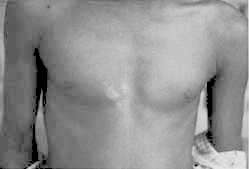
Figure 1. Hypopigmented macule on chest of an Indian youth who, as a child, said he remembered the life of a man, Maha Ram, who was killed with a shotgun fired at close range.
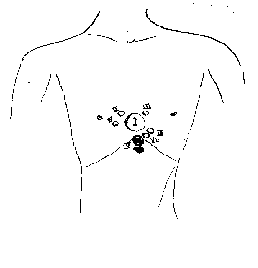
Figure 2. The circles show the principal shotgun wounds on Maha Ram, for comparison with Figure 1. [This drawing is from the autopsy report of the deceased.]
INTRODUCTION
Although counts of moles (hyperpigmented nevi) have shown that the average adult has between 15 and IX of them (Pack and Davis, 1956), little is known about their cause -- except for those associated with the genetic disease neurofibromatosis -- and even less is known about why birthmarks occur in one location of the body instead of in another. In a few instances a genetic factor has been plausibly suggested for the location of nevi (Cockayne, 1933; Denaro, 1944; Maruri, 1961); but the cause of the location of most birthmarks remains unknown. The causes of many, perhaps most, birth defects remain similarly unknown. In large series of birth defects in which investigators have searched for the known causes, such as chemical teratogens (like thalidomide), viral infections, and genetic factors, between 430/0 (Nelson and Holmes, 1989) and 65 -- 70% (Wilson, 1973) of cases have finally been assigned to the category of "unknown causes."
Among 895 cases of children who claimed to remember a previous life (or were thought by adults to have had a previous life), birthmarks and/or birth defects attributed to the previous life were reported in 309 (35%) of the subjects. The birthmark or birth defect of the child was said to correspond to a wound (usually fatal) or other mark on the deceased person whose life the child said it remembered. This paper reports an inquiry into the validity of such claims. With my associates I have now carried the investigation of 210 such cases to a stage where I can report their details in a forthcoming book (Stevenson, forthcoming). This article summarizes our findings.
Children who claim to remember previous lives have been found in every part of the world where they have been looked for (Stevenson, 1983; 1987), but they are found most easily in the countries of South Asia. Typically, such a child begins to speak about a previous life almost as soon as it can speak, usually between the ages of two and three; and typically it stops doing so between the ages of five and seven (Cook, Pasricha, Samararatne, Win Maung, and Stevenson, 1983). Although some of the children make only vague statements, others give details of names and events that permit identifying a person whose life and death corresponds to the child's statements. In some instances the person identified is already known to the child's family, but in many cases this is not so. In addition to making verifiable statements about a deceased person, many of the children show behavior (such as a phobia) that is unusual in their family but found to correspond to behavior shown by the deceased person concerned or conjecturable for him (Stevenson, 1987; 1990).
Although some of the birthmarks occurring on these children are "ordinary" hyperpigmented nevi (moles) of which every adult has some (Pack and Davis, 1956), most are not. Instead, they are more likely to be puckered and scarlike, sometimes depressed a little below the surrounding skin, areas of hairlessness, areas of markedly diminished pigmentation (hypopigmented macules), or port-wine stains (nevipammri). When a relevant birthmark is a hyperpigmented nevus, it is nearly always larger in area than the "ordinary" hyperpigmented nevus. Similarly, the birth defects in these cases are of unusual types and rarely correspond to any of the "recognizable patterns of human malformation" (Smith, 1982).
METHODS
My investigations of these cases included interviews, often repeated, with the subject and with several or many other informants for both families. With rare exceptions, only firsthand informants were interviewed. All pertinent written records that existed, particularly death certificates and postmortem reports, were sought and examined. In the cases in which the informants said that the two families had no previous acquaintance, I made every effort to exclude all possibility that some information might nevertheless have passed normally to the child, perhaps through a half-forgotten mutual acquaintance of the two families. I have published elsewhere full details about methods (Stevenson, 1975; 1987).
I did not accept any indicated mark as a birthmark unless a firsthand witness assured me that it had been noticed immediately after the child's birth or, at most, within a few weeks. I enquired about the occurrence of similar birth marks in other members of the family; in nearly every instance this was denied, but in seven cases a genetic factor could not be excluded.
Birth defects of the kind in question here would be noticed immediately after the child's birth. Inquiries in these cases excluded (again with rare exceptions) the known causes of birth defects, such as close biological relationship of the parents (consanguinity), viral infections in the subject's mother during her pregnancy, and chemical causes of birth defects like alcohol.
RESULTS
Correspondences between Wounds and Birthmarks
A correspondence between birthmark and wound was judged satisfactory if the birthmark and wound were both within an area of 10 square centimeters at the same anatomical location; in fact, many of the birthmarks and wounds were much closer to the same location than this. A medical document, usually a postmortem report, was obtained in 49 cases. The correspondence between wound and birthmark was judged satisfactory or better by the mentioned criterion in 43 (88%) of these cases and not satisfactory in 6 cases. Several different explanations seem to be required to account for the discrepant cases, and I discuss these elsewhere (Stevenson. forthcoming). Figure 1 shows a birthmark (an urea of hypopigmentation) on an Indian child who said he remembered the life of a man who had been killed with a shotgun fired at close range. Figure 2 shows the location of the wounds recorded by the pathologist. (The circles were drawn by an Indian physician who studied the postmortem report with me.)
The high proportion (88%) of concordance between wounds and birthmarks in the cases for which we obtained postmortem reports (or other confirming documents) increases confidence in the accuracy of informants' memories concerning the wounds on the deceased person in those more numerous cases for which we could obtain no medical document. Not all errors of informants memories would have resulted in attributing a correspondence between birth marks and wounds that did nor exist; in four cases (possibly five) reliance on an informant's memory would have resulted in missing a correspondence to which a medical document attested.
Cases with Two or More Birthmarks
The argument of chance as accounting for the correspondence between birthmarks and wounds becomes much reduced when the child has two or more birthmarks each corresponding to a wound on the deceased person whose life he claims to remember. Figure 3 shows a major abnormality of the skin (verrucous epidermal nevus) on the back of the head of a Thai man who, as a child, recalled the life of his uncle, who had been struck on the head with a heavy knife and killed almost instantly. The subject also had a deformed toenail of the right great toe (Figure 4). This corresponded to a chronic infection of the same toe from which the subject's uncle had suffered for some years before he died.
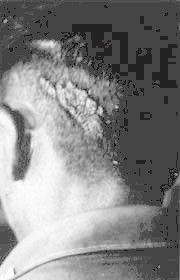
Figure 3. Large verrucous epidermal nevus on head of a Thai man who as a child said he remembered the life of his paternal uncle, who was killed with a blow on the head from a heavy knife.
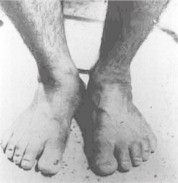
Figure 4. Congenital malformation of nail on right great toe of the Thai subject shown in Figure 3. This malformation corresponded to a chronic ulcer of the right great toe from which the subject's uncle had suffered.
The series includes 18 cases in which two birthmarks on a subject corresponded to gunshot wounds of entry and exit. In 14 of these one birthmark was larger than the other, and in 9 of these 14 the evidence clearly showed that the smaller birthmark (usually round) corresponded to the wound of entry and the larger one (usually irregular in shape) corresponded to the wound of exit. These observations accord with the fact that bullet wounds of exit are nearly always larger than wounds of entry (Fatteh, 1976; Gordon and Shapiro, 1982). In addition to the 9 cases I have investigated myself, Mills reported another case having the feature of a small round birthmark (corresponding to the wound of entry) and a larger birthmark corresponding to the wound of exit (both verified by a postmortem report) (Mills, 1989).
I have calculated the odds against chance of two birthmarks correctly corresponding to two wounds. The surface area of the skin of the average adult male is 1.6 meters (Spalteholz, 1943). If we were to imagine this area square and spread on a fiat surface, its dimensions would be approximately 127 centimeters by 127 centimeters. Into this area would fit approximately 160 squares of the size 10 centimeters square that I mentioned above. The probability that a single birthmark on a person would correspond in location to a wound within the area of any of the 160 smaller squares is only 1/160. However, the probability of correspondences between two birthmarks and two wounds would be (1/160)2 i.e. 1 in 25,600. (This calculation assumes that birthmarks are uniformly distributed over all regions of the skin. This is incorrect [Pack, Lenson, and Gerber, 1952], but I believe the variation can be ignored for the present purpose.)
Source : site sur les NDE